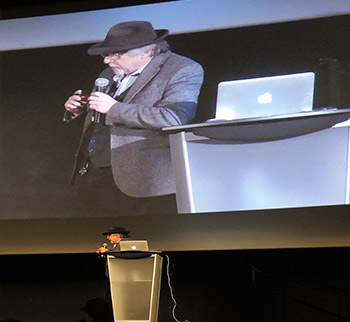Art Spiegelman was exhausted – he had just returned from China. The condition, he conceded apologetically, caused him to be a bit rambling and unedited. But the beneficiary was a packed audience Jan. 26 at the Bloor Hot Docs Cinema.
The storied cartoonist and creator of Maus, now lauded as a touchstone in both the “graphic novel” genre as well as in Holocaust education, took the crowd through a freewheeling, hour-long appreciation of comics, free speech, his Jewish sensibilities and, in the wake of the Charlie Hebdo massacres, how perilous a craft cartooning can be.
Drawing chuckles, Spiegelman said he’s been called the father of the graphic novel, “but I’m demanding a blood test.”
Mainly, he dwelled on the topic of his talk, presented by the Koffler Centre of the Arts: “What the %&@! Happened to Comics?” Whether political, journalistic or just fun, comics and cartooning (not the same things, he stressed) have lost their bite and whimsy, at least in North America, he claimed.
That’s a pity, he added, because humans, Spiegelman believes, are hardwired to think in comic-like panels of single images and “in little bursts of language.”
Now 66, Spiegelman recounted growing up in New York on a steady diet of comic books. He learned to read from Batman, philosophy from Peanuts, politics from Pogo and about sex by contemplating Betty and Veronica of Archie fame. “Everything else” came from Mad magazine, which, in its earliest incarnations, was widely denounced as crude and subversive.
“I studied Mad the way some kids studied the Talmud,” he quipped. “It changed my life. It made me want to be a cartoonist.” To him, Mad, which was written mainly by Jews, “was my window into America from a dysfunctional refugee household” and “a secular Jewish response to Auschwitz.”
His Polish Holocaust survivor parents, however, “didn’t see it that way.”
As is well known by now, Spiegelman’s crowning achievement was Maus, a monumental, stirring and hugely innovative story, told in cartoon form, of his parents’ survival of the Nazi era and their later lives in America. Famously, Jews are depicted as mice, Germans as cats, Americans as dogs and Poles as pigs. Maus was the first graphic novel to win a Pulitzer Prize in 1992 and is widely used as a teaching tool.
Spiegelman explained briefly how his animal representations came to be. Partly, they were a result of the standard cat versus mouse food chain in comics and cartoons, but he also built on earlier anti-Semitic depictions of Jews as rodents.
With overhead photos and reproductions, he showed images from the Nazi newspaper Der Sturmer and several anti-Semitic cartoons depicting Jews as unclean rats infecting the German body politic. The intent was to dehumanize Jews. “It’s necessary to dehumanize in order to kill,” Spiegelman said, “and it was no accident that Zyklon B (used in gas chambers) was a pesticide.”
Post-Maus, Spiegelman felt he had to re-invent himself, so he went to work for the New Yorker, where his first cover art, in 1993, showed a chassidic man in a deep embrace and kiss with a black woman. It was meant to convey conciliation in the raw weeks following the riots in Crown Heights between Jews and African-Americans, “but all hell broke loose,” Spiegelman recalled. “Everybody was upset by it.”
He redeemed himself somewhat with a post-9/11 cover that appeared as funereal all-black but which actually showed the twin towers when viewed at a certain angle.
As for Charlie Hebdo, Spiegelman claimed the French satirical newspaper is not anti-Islamic but an offender of all religions, including the Catholic Church. He likened it to the television cartoon South Park, and though juvenile, “it relishes the ability to speak its mind, whether that’s good or bad.”
He showed a variety of covers from the publication, and also the infamous 2006 Danish editorial cartoons of Muhammad that generated global controversy.
Though he never wanted to be a political cartoonist, Spiegelman waded into the fray himself in the wake of a contest a few years ago in Iran for best anti-Semitic cartoon. Published in the New Yorker, Spiegelman’s efforts succeeded as satire because they held Iran’s contest in contempt.
Ultimately, he said, political cartoons have lost their “sting” in America because of declining newspaper readership coupled with the fear of offending.
The Art Gallery of Ontario continues its exhibit of Spiegelman’s work. Art Spiegelman’s CO-MIX: A Retrospective runs to March 14.
